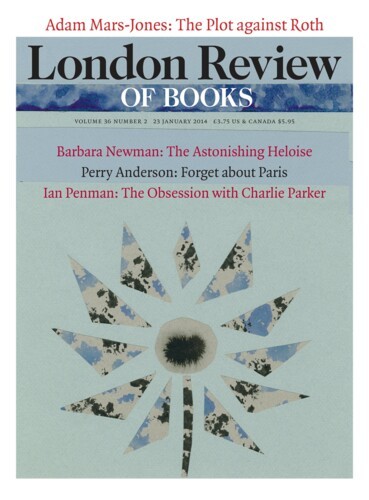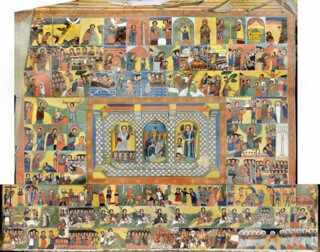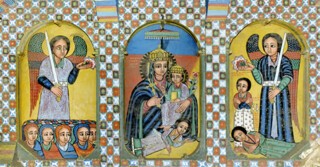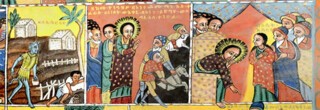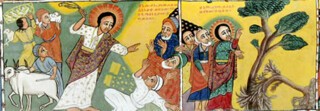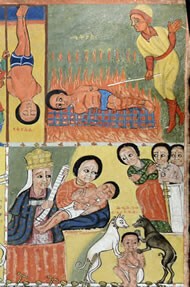You might think you’re looking at an advent calendar, but there is no Nativity in this stunning set of paintings from the church of Däräsge Maryam in northern Ethiopia. The church was built by order of Webe Hayla Maryam, an energetic Amhara warlord, in the 1850s. By then Webe’s conquests had taken him as far as Tigray and the Red Sea port of Massawa in his bid to become emperor of a unified state. Däräsge Maryam was completed in 1852, under the supervision of two of Webe’s German protégés, the botanist Georg Wilhelm Schimper and the artist Eduard Zander. This photograph of the East Wall of the maqdas – the holy of holies at the centre of the church – is from The Story of Däräsge Maryam by Dorothea McEwan, the Warburg’s archivist from 1993 to 2006 (Lit Verlag, £33). McEwan made three visits to the site, the last in 2009. She reports that the complex, which includes a tower, a storehouse and gatehouses, was in reasonable shape despite ‘large cracks’ in the wooden door frames and stone walls. The church itself is in good repair, and the paintings – executed on cloth and pasted to the wattle-and-daub walls with glue – are well preserved.
Each wall of the maqdas measures about six metres by six metres. In the three blind windows at the centre of the East Wall are the Archangels Michael and Gabriel, either side of Mary and the Child (plus prostrate donor). Michael (left) raises a flower, by way of a blessing, above a group of disciples, who look towards Mary, another of their safekeepers. Gabriel (right) blesses Ephrem, the Syrian hymnist, shown here as a potter – he seems to have borrowed this attribute from Simeon the potter – with two white jars to his right. The prone figure at Gabriel’s feet is an unknown ‘Gyorgis’, possibly another donor.
The smaller scenes surrounding the windows are illustrations of the Hebrew Bible and the Gospels. First left on the top register is an angel staying Abraham’s hand as he prepares to sacrifice Isaac, followed by Jacob dreaming of the ladder to heaven, and so on along to (far right) Daniel explaining Nebuchadnezzar’s dream: no sign of the pulverised statue, but the rock and the mountain are there. The second register moves briskly to Christ’s ministry with the Sermon on the Mount on the left, followed by the wedding at Cana, and on through the Gospels, past a liverish Satan sowing tares under a lemon sky, to the woman taken in adultery as Christ writes in the dust (‘Let him who is without sin’ etc). In scene six of the third register, Christ the activist is in the Temple, casting out the currency traders; purveyors of high-cholesterol meat and dairy products beat a hasty retreat to his left. In the next scene (climate change), he calms the four winds of heaven.
On the upper register of the plinth, at the left, between the True Cross and the cross of the risen Christ is a scene from the first Council of Nicaea. The council is in session and on closer inspection so is the heretic Arius, who did not believe the Son was equal to the Father. He can be found in his white hood and smock secluded in a little niche squatting over a magnificent turd. Further along: the crucifixion of St Peter, the beheadings of St Paul and St Matthew, the garotting of St Mark in Alexandria and other dark deeds. On the far right St Matthias is roasted on a gridiron. Directly below Matthias in the second register is the figure of Gabra Krestos, who forsook his wealthy family for a life of poverty, but his dogs have recognised him and stand on their hind legs with their paws on his shoulders. In the dazzling procession in the bottom register, Webe himself appears on a grey horse, his bare head shielded by a retainer’s umbrella. Webe had hoped to wear the imperial crown, and to have his coronation at Däräsge Maryam. But in a final confrontation with his rival Kasa Hailu in February 1855, he was wounded and his force was routed. Two days later, Kasa Hailu was crowned emperor of Ethiopia, and took the name Tewodros II, at a ceremony held in the church that Webe had commissioned and endowed.
Send Letters To:
The Editor
London Review of Books,
28 Little Russell Street
London, WC1A 2HN
letters@lrb.co.uk
Please include name, address, and a telephone number.
